Sciatica is an extremely common problem. So common, in fact, that 1 in 10 people will suffer from sciatica at some point in their lives. Today, we’re going to talk about how sciatica is treated, the symptoms someone with this problem might get and the ideal treatment to get it better as fast as possible!
What is Sciatica?
Before we talk about how sciatica is treated, we need to understand sciatica a bit better.
The term “sciatica” actually means one very simple thing – pain in the leg related to a nerve. Strictly speaking, “sciatica” refers to the sciatic nerve, which is responsible for the pain down the back of the leg that can travel all the way to the toes.
Sciatica is not a “disease” in and of itself. “Sciatica” simply describes a set of symptoms, which we will come to later.
There are many potential causes for sciatica symptoms. A large proportion of these causes are due to a problem within the lower back. However, the location of the problem can also be the hip, or even further down the leg.
Without doubt, the lower back (or the “lumbar spine” if speaking to a medical professional) is the area that causes the most cases of sciatica. Let’s learn how the lower back is responsible for most sciatica symptoms…
The Lower Back
The lower back is made up of 5 bony segments, called vertebrae, all stacked upon one another. Between these vertebrae are the intervertebral discs, tough sacs made up of strong fibres called “collagen”, combined with water and nutrients.
These discs are responsible for shock absorption through the spine, as well as lubrication of movement.
The joints that join these bony vertebral segments together are called “facet joints”. They allow the vertebrae above to move with the vertebrae below, with the assistance of a lubricating substance called “cartilage”.You’ve probably heard of cartilage before – it is the substance that wears away in the process called “arthritis”.
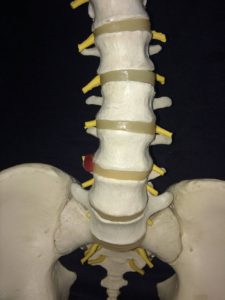
There are 24 vertebral bones in the spine, with 5 of them making up the lower back. In the centre of the vertebral bones within the lower back, runs the spinal cord.
When this reaches the bottom of the spine, it splits off into a network of nerves (called the “cauda equina” after the Latin term for a “horse’s tail” which refers to its appearance). You can see a really useful picture of the cauda equina HERE.
These nerves then leave the spine at each of the 5 lowest levels in the back, initially via a nerve root which then becomes a fully functional nerve.
This functional nerve then runs into the leg, supplying the skin with sensation and our muscles with the signals that allow them to work.
How Do Nerves Work?
To understand how sciatica symptoms occur, we must first understand how these nerves work.
The easiest way to get our heads around this is to imagine nerves as long cords in the body, that start in the spinal cord (which runs from the brain to the tail), and leave the spine through small gaps between the vertebrae.
Nerves send signals up to the brain from our body about touch, sensation and pain. Equally, the brain sends instructions down the nerves to our muscles, to make them move so we can walk, talk and eat.
You can think of the nerves as mini-motorways inside our body. On these motorways, the cars travelling down represent the signals that are sent from our brain to our limbs, and the cars that travel in the opposite direction represent the signals sent from our limbs to the brain.
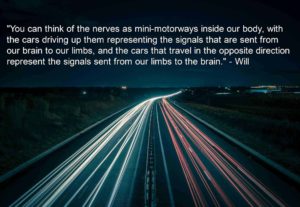
When we have a healthy nerve, the signals travel smoothly, within the “speed limit”, and without running into any traffic.
Sciatica occurs when the transmission of these important signals is affected.
We will go further into detail on the topic of what problems can actually cause sciatica symptoms later in this post.
But now let’s talk about the sciatica symptoms that someone with sciatica may experience.
Sciatica Symptoms
This section will go over the well-known symptoms of this condition, as well as uncovering some of the lesser known sciatica symptoms, too.
- Pain in the leg: This is one of the classic sciatica symptoms. The pain that you feel follows the course of the affected nerve in your leg. If the sciatic nerve is affected, you feel pain down the back of the leg, sometimes all the way to the toes. This is because that is the path that the sciatic nerve takes.The classic sciatic pain we see starts from the back or buttock and runs all the way down the back of the leg in a shooting line. It is also possible for the pain to be felt in one area of the leg only. Often this is the case in the calf.The pain can be described as sharp and shooting, “like an electric shock”, but it is also possible for sciatica to be felt as a dull throbbing ache, too. If it is not the sciatic nerve that is affected, the pain can run down the side of the leg, or down the front of the leg. It can also run into the groin, too.
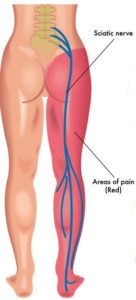
- Pins and needles or numbness in the legs or feet: This symptom is very common in people who suffer from sciatica symptoms, and is caused by the same thing that causes the leg pain.Often, the pins and needles or numbness will affect the same areas in the legs as the pain does. These sensory changes can range from a tingle, “fizzing”, or slightly “dull” feeling, to complete loss of sensation, depending on severity.
- Loss of strength in a muscle group in the legs: When the affected nerve gets compressed to a point that the signals within that nerve cannot be carried effectively to the muscles any more, loss of strength occurs. This can be quite a serious symptom, and if you feel this may be happening to you it is advisable to get a check-up from a doctor as soon as you can.
- Back pain: Back pain very often accompanies sciatica. This is because, usually, the problem that causes sciatica symptoms is actually within that person’s back. It is entirely possible to have the other sciatica symptoms without any back pain. Not all causes of back pain also cause sciatica.
Why do we get these sciatica symptoms?
This part will hopefully answer all the “why” questions you might have about the symptoms you are experiencing. Like we spoke about earlier, having a full understanding of why something happens helps us understand how best we treat it.
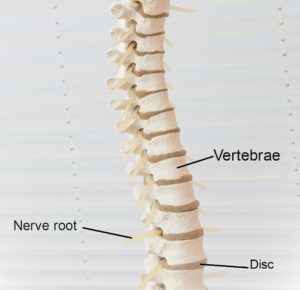
As we can see in the picture, our spines are very complex. We have 7 cervical vertebrae (bones in the neck), 12 thoracic vertebrae (bones in the mid-back), 5 lumbar vertebrae (bones in the lower back) plus 1 sacrum (tail bone).
Between each one of these vertebrae are the intervertebral discs, that we spoke about before. Each disc has a soft inner section – called the nucleus – and a tough outer section called the annulus.
The spinal cord runs through the vertebrae, protected by the strong bones, discs and ligaments that hold the spine together.
Branching off from the spinal cord we have nerve roots (seen clearly in the picture below) that leave the spine and re-converge to become the main nerves in the body. The main nerves within the legs all begin in the part of the spinal cord that sits in the lumbar spine (lower back).
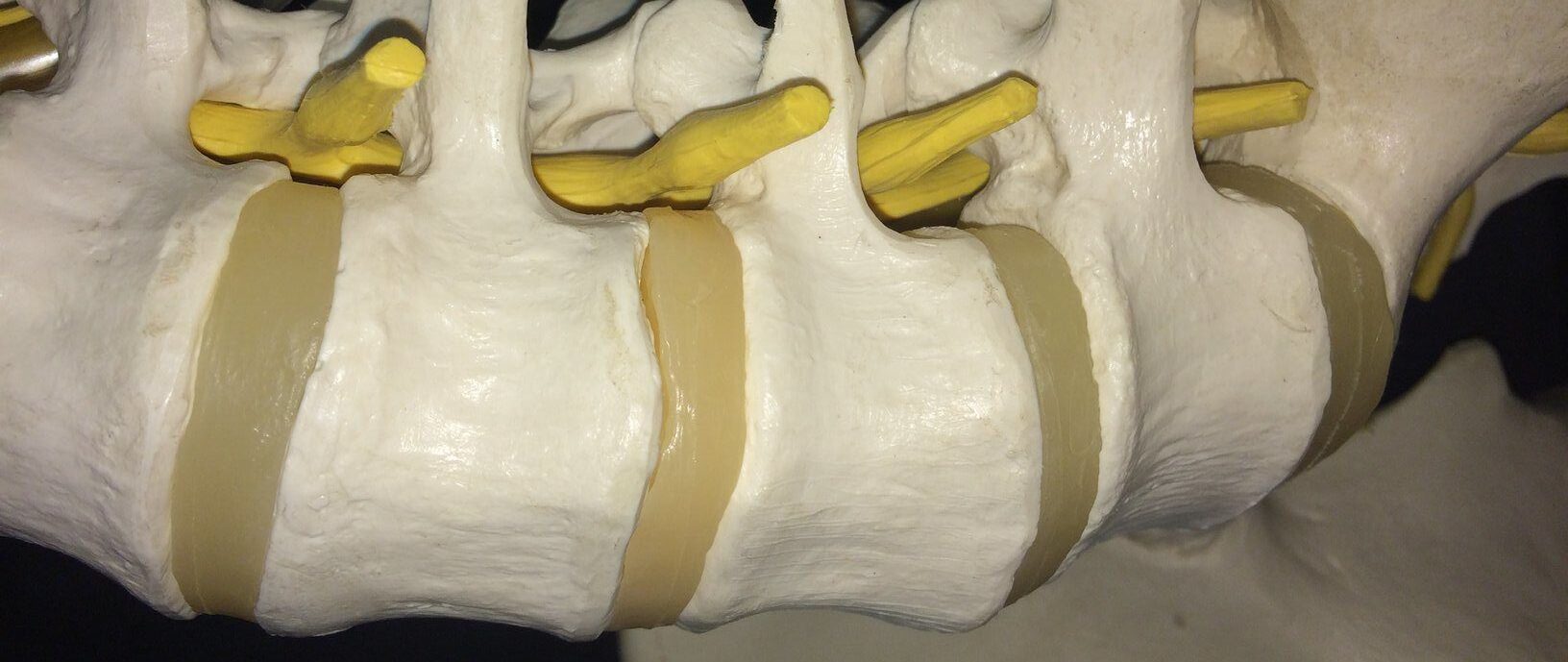
You can see in the picture the nerve roots of the lower 4 vertebrae. The nerve roots are in yellow. The bottom 2 nerve roots (plus 3 from the sacral region lower down) will converge to make up the sciatic nerve.
The sciatic nerve is the biggest nerve in the human body. It is roughly three-quarters of an inch across and runs all the way from the lower back to the toes, via the back of the leg.
Going back to the motorway analogy we used earlier, the sciatic nerve is like a huge motorway, with cars (signals) running up and down its length constantly.
So What Goes Wrong in Sciatica?
Something that has become obvious to the medical profession as a whole is this: nerves do not like to be touched!
Touching, pinching or compressing a nerve causes reactions around that area, causing pain along the entire course of the nerve.
You will get sciatica symptoms from the direct contact but also a chemical reaction around that area which exacerbates these symptoms.
The chemical reaction that occurs when we compress a nerve, especially when disc material touches the nerve, is similar to the type of reaction we get when we are stung by a bee.

Chemical irritants, like “substance P” and “histamine” remain for some time in the affected area, causing further inflammation to the nerve root and pain along the course of the nerve.
Not a happy combination!
So, generally speaking, sciatica symptoms are caused by something touching, pinching or compressing the affected nerve. This usually happens in the lower back, as the lower back is where the nerve roots run through tight spaces. This leaves them vulnerable to being contacted if a structure in the back has invaded the space within which the nerve runs through.
So what goes on to cause us sciatica symptoms?
The structures in the back that can affect the nerves are:
- The intervertebral discs: The tough outer part of the intervertebral discs can develop micro-tears over time through repetitive movements under load. These micro-tears can develop into “bulges”, which occur when pressure causes the inner material in the disc to push into these weakened zones. These bulges can encroach on the tight spaces that the nerve roots run through.In a worst case scenario, the inner material of the disc can actually leave the side of the disc through these weakened areas, causing a chemical reaction around the nerve root leading to sciatica. This often gets worse when a person bends forward, as pressure on the front of the disc causes the inner material to “bulge” backwards towards the nerve root, irritating it and causing sciatica symptoms.
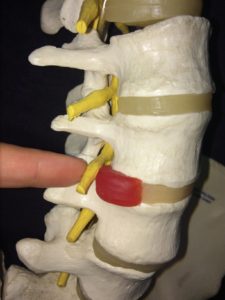
In the above picture, you can see what it looks like when a disc bulges slightly. The red area represents the bulge, and this will press on the yellow nerve root, causing pain all along the course of the nerve.
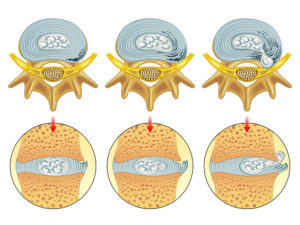
- General age-related changes to facet joints and discs: As we age, our discs dry out and lose height, the bone around our joints thickens, our joints become stiffer and we lose the cartilage that helps to lubricate movement in our spines.All of these changes equate to a smaller and less lubricated space for the nerve roots to exit the spine from, causing them to become compressed. When this compression becomes more severe, it leads to a condition called “spinal stenosis”.
- Piriformis syndrome: In some people, the sciatic nerve runs through a muscle in the buttock region called the Piriformis. When this muscle gets tight, the nerve can become compressed in the buttock, causing similar pain and numbness to the other types of sciatica.
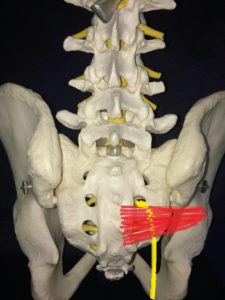
- Fractures: In rare cases, a fracture of one of the vertebrae can cause a compression on a nerve root. This can happen following trauma, like a fall, but if someone has a condition called “osteoporosis” then fractures can occur spontaneously. Osteoporosis is a condition that causes a thinning of the bones and is more common in women and the elderly.
- Tumour or growth: Very rarely, a cyst, tumour or other lesion can occur in the spine which then leads to a nerve root compression. This type of problem is luckily not very common. We will talk about “red flags” for tumours later in this post. If you’re really worried about this being a cause for your sciatica, please go and seek help from your doctor, who can hopefully put your mind at rest.
Before we go any further, I have a recommendation for you. My good friend, colleague and fellow international sciatica expert, Dean Volk, has a brand new sciatica relief video course available – ideal for anyone suffering who wants to accelerate healing from sciatica.

Check out Dean Volk’s “Kicking Sciatica OUT of the Butt!” Online Pain Relief Course Here!
I can proudly recommend Dean and his course for sciatica sufferers – because I’ve seen his incredible results first-hand. You can check out his course (and get lifetime access to the videos and bonus content) by clicking HERE.
How Sciatica is Treated
When we talk about treatment for sciatica, we need to split this category into two parts:
- Lifestyle
- Exercise
How Sciatica is Treated Part #1: Lifestyle
Diet
It’s crucial that you optimise your diet for a recovery from sciatica.
This involves maximising anti-inflammatory foods: click HERE to learn more about anti-inflammatory foods for sciatica.
You’ll also need to minimise pro-inflammatory foods: click HERE to learn about which foods to AVOID when you have sciatica.

General Activity
You need to keep generally active. This means not taking too much time off work.
You should try to walk as much as you can within the realms of comfort. Stop when pain starts, have a break, then get back to it.
One of my clients used to leave his house, walk up the road 100 yards, then come back. That was it for each day. But even those few hundred steps made a huge difference over a number of weeks.
Little and often is key – don’t overdo it. Make sure you stop as soon as your pain starts to worsen. Each day, you’ll be able to build your activity level gradually.
Hydration
Drinking plenty of water is absolutely crucial. When you have a herniated disc compressing a nerve, any dehydration in that disc will make the compression worse.
This means that drinking 3-4 litres of water each day is critical to your success and a highly undervalued facet of recovery.

Sleep
Getting as much sleep as possible is incredibly important when you have sciatica (although, sciatica can make sleep more difficult unfortunately).
Sleep is one of the key parts of a recovery from sciatica – sleep is when healing occurs. It’s impossible to get better without ample sleep each night.

One helpful tip to remember is that you can make up for lost hours of sleep as a nap if your pain tends to be worse at night. A 20-minute nap has been shown to be as effective as two hours of extra sleep in the morning in terms of restoration, some research shows.
Click HERE for a brief guide on sleeping better when you have sciatica.
Minimising Discomfort to Speed Up Recovery
Getting better from sciatica is just as much about avoiding making the problem worse as it is about doing extra things.
As a general rule of thumb, if an activity or position is making your pain worse, you need to change it or you run the risk of delaying your disc recovery time.
Products That Can Help
For sciatica, there are a number of products that can help you go about your day with less pain and more comfort. Here are a few of my top recommended products for treating sciatica:
#1 – TENS Machine
TENS machines are useful for providing relief from pain and muscle spasms in the back and legs. They are a safe and effective way of relieving your symptoms without any effort on your part.
Below are 3 of my top recommended TENS machines for relief from sciatica:
TENSCare Perfect TENS Pain Relief Machine


This TENS machine for sciatica has 8 preset programs so you don’t need to “tune it” yourself – just pick a setting and off you go!
There is an option to purchase a ‘Value Pack’ which includes spare pads which I would definitely recommend.
Click HERE to view the TENSCare Perfect TENS Pain Relief Machine on Amazon US (closest match)
Click HERE to view the TENSCare Perfect TENS Pain Relief Machine on Amazon UK
TPN 200 Plus TENS Machine


A super-simple yet sleek design, this TENS machine is perfect for those who want a highly effective model and are confident with using a TENS machine for sciatica pain relief. This unit doesn’t have a fancy display, so you can customize the settings to best suit your needs, tweaking and changing the frequency until you find one that works best for you.
Click HERE to view the TPN 200 Plus TENS Machine on Amazon UK
Click this link here to read about our 10 Best Recommended TENS Machines for Sciatica!
#2 – Lumbar Roll
A lumbar roll is a specially designed cushion that goes behind your lower back when sitting.
It increases the curve in the lower back, which many people find takes pressure off a herniated disc when sitting (which can be the worst position for a lot of people).
Here is a great option for a lumbar roll for the office, car and home:


Click HERE to view the Supportiback® Posture Therapy Lumbar Support Cushion on Amazon
#3 – How to Treat Sciatica with Topical Creams
There are a number of rubs and creams that can help to relieve pain from sciatica. In this section of the article, I’m going to share with you which products I believe to be the best creams for sciatica pain relief.
Always consult your doctor before starting any new medication, including creams.
Best Cream for How to Treat Sciatica Pain – Voltarol


Click HERE to view Voltarol cream for sciatica pain relief Amazon US
Click HERE to view Voltarol cream for sciatica pain relief Amazon UK
This product contains an anti-inflammatory that helps to calm any inflammation around the affected nerve root when someone is suffering from sciatica.
What’s more, it also contains a natural product that will help to relax hyper-tense muscles and reduce pain, as well as provide a soothing effect to the area. For this reason, I would place it as my go-to and best cream for sciatica pain relief.
Second Best Cream for Treating Sciatica Pain – 5Kind Hemp Active Gel


View this product on Amazon here
Hemp-based products have grown in popularity over the last few years. I always keep a close eye on the research regarding hemp and CBD – and the research shows mixed results.
Anecdotally, I’ve heard great things from users of hemp gel as a cream for sciatica pain relief, and I had one client that used it to relieve back pain to great effect.
The product shown is one of the best on the market right now with over 11,000 ratings and an average of 4.5/5 stars!
Third Best Cream for Treating Sciatica – FourFive CBD Muscle Rub

Click HERE to view this cream for sciatica pain relief on Amazon
I was never convinced by the CBD craze when it all began, but I am starting to see more compelling evidence for its use in some people, in some cases.
While I don’t believe CBD to be “magic”, I do feel this product has potential to relieve some of the muscle pain experienced in the lower back for many people with sciatica.
That is why this product makes it onto the list of the best creams for sciatica pain relief. Check out the reviews of this product – they are outstanding, with a perfect 5-star rating.
What Other Products for Can Help for Treating Sciatica?
I’m a big believer in the power of improving your general health when it comes to sciatica pain relief.
If you’re struggling with your mobility due to sciatica, one thing that might help is to address other general health issues like your weight, your diet and your general exercise.
If you’d like some tips on how to improve all of those aspects of your health, stave off injury and treat problems like arthritis, why not grab a copy of my brand new book, Thriving Beyond Fifty? You can see more details below:
Top Tip: Grab a copy of my #1 Best-Selling book, Thriving Beyond Fifty for more health, wellness and recovery strategies!

How Sciatica is Treated: Exercises
The most important thing to understand when it comes to sciatica and exercise is that everyone is different; a suitable exercise regime for one person with sciatica will be different for another with the same problem.
However, there are some exercises that are commonly useful for many people with sciatica.
Only choose exercises that are non-painful and don’t make your symptoms worse during and after you finish the exercise.
Always go gently at first and build up slowly. Check with your GP before starting any new exercise programme.
The exercises provided on this page for informational purposes only and are not designed to be a ‘prescription’ of any kind. Be sure to check with your healthcare provider before you begin any new exercise programme.
#1 – Cobra Pose
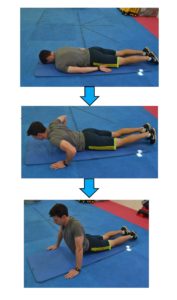
Instructions:
- Begin laying face-down on a firm surface like a mat on the floor or a hard mattress
- Place your hands in line with your shoulders and gently push up, raising your torso off the floor
- Keep your hips down on the floor
- Only go as far as is comfortable – no need to get to full extension for a benefit!
- Gently lower yourself to the starting position and repeat up to a maximum of 10 times.
- Do a set of these 3-4 times per day
Who this is for:
Usually, people suffering with a herniated disc find this exercise one of the most useful for improving their symptoms. However, regardless of what is causing your sciatica, you should only persist with this exercise if it is comfortable to perform this movement. This exercise is a good place to start if you have trouble bending forward.
Why this exercise works as treatment for sciatica:
This sciatica exercise works because it involves movement of the lower back which encourages blood to flow to the injured area so healing can occur. Some researchers also believe this exercise causes a disc bulge to “centralise” into the disc where it can’t pinch on a nerve root.
#2 – Knee Rolls
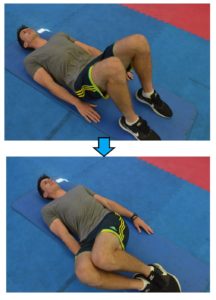
Instructions:
- Lie on your back on a mat or a firm mattress
- Bend your knees up halfway
- Slowly and gently, allow both knees to roll over to one side only as far as is comfortable
- Bring your knees back to the start position, then allow them to roll over to the opposite direction
- Repeat for 30-seconds total, don’t rush the repititions and try to find a rhythm
- Try to find time to do this exercise every 2-3 hours if you can
Who this is for:
This sciatica exercise is great for relieving any tension in tight muscles in the lower back. It is also a great way to begin to regain any lost rotation in the lower back following a herniated disc.
Why this exercise works for treating sciatica:
By gently encouraging a slow, controlled rotation of the lower back, the muscles in your lower back will realise that it is OK to relax a little. This will bring about herniated disc pain relief.
#3 – McKenzie Side Bends

Instructions:
- Start standing next to a wall. Most people prefer to do this exercise with their painful leg being the one FURTHEST AWAY from the wall. However, try both sides and see which one is most comfortable for you – stick with that one.
- Use your elbow and forearm to support yourself so you are leaning on the wall (1st picture)
- Slowly and gently, let your hips “glide” towards the wall while keeping your feet in the same position.
- Only go as far as is comfortable, then return to the start position.
- Repeat this 10 times, have a break, and do 3 sets total.
- If this exercise has worked for you, you may feel rapid relief in the painful leg and possibly slightly worsening back pain – rest assured this is a normal phenomenon.
Who this is for:
This exercise works really well for disc problems and is a mainstay for a treatment approach called “McKenzie”. If you have pain in one leg only from a disc bulge or prolapse, you could try this exercise. It brings significant sciatica pain relief to many people and can work rapidly.
Why this exercise works for treating sciatica:
The McKenzie approach claims to work by encouraging the disc material called the “nucleus pulposus” to re-centralise into it’s inner middle. Whether or not this actually occurs hasn’t been proven in scientific literature but I have seen this exercise provide relief for many. Be sure to choose the direction that is least painful when performing this sciatica exercise.
#4 – Standing Extension
Instructions:
- Start standing normally.
- Gently try to lean back. Only go as far as is comfortable.
- If you feel able to, use your hands to provide support in the lower back allowing you to extend further (3rd picture)
- Slowly return to the start position
- Perform up to 10 repetitions, every few hours or so. Cut your set short as soon as you reach the first signs of pain.
Who this is for:
This is a great sciatica exercise for a herniated disc as well. It works especially well for people who have trouble leaning forward and is a more user-friendly/convenient version of #1 on this list. However, I find it to be slightly less effective compared to the Cobra pose as I find people tend to rely more on pelvic rather than spinal movement with this one.
You should AVOID this exercise if you suffer from arthritis of the lower back or spinal stenosis.
Why this exercise works for sciatica treatment:
This exercise works in a similar way to #1 – it involves movement of the lower back, encouraging blood to flow to the injured area so disc healing can occur. This exercise may help a herniated disc to “centralise” into the inner disc where it can’t pinch on a nerve root.
Other Options for How to Treat Sciatica
Very rarely, surgery is required for a herniated disc. This intervention is reserved for those who have tried everything else and are still suffering.
It’s important to exhaust all non-surgical methods first, as you can’t reverse a surgery and the results from surgery are often underwhelming. Occasionally, surgery can make someone worse which is obviously devastating to hear about.
Another option includes injections, which can give pain relief down the course of the sciatic nerve. From my experience, these have very underwhelming results for most people. However, they can occasionally be effective.
A further option is a PROVEN exercise programme, like the one below that I proudly support:
Are You Looking for RAPID Relief from Sciatica?
My good friend, colleague and fellow international sciatica expert, Dean Volk, has a brand new sciatica relief video course available – and I’m delighted to be an official sponsor!

Check out Dean Volk’s “Kicking Sciatica OUT of the Butt!” Online Pain Relief Course Here!
I can proudly recommend Dean and his course for sciatica sufferers – because I’ve seen his incredible results first-hand. You can check out his course (and get lifetime access to the videos and bonus content) by clicking HERE.
Top Tip: Grab a copy of my #1 Best-Selling book, Thriving Beyond Fifty for more health, wellness and recovery strategies!

The information on Overcome Sciatica should never be used as a substitute for medical advice from a doctor. Never put into action any tips or techniques from Overcome Sciatica without checking with your doctor first. Please see full terms of use here.
Conclusion
I hope you’ve found this article helpful. I think it’s useful to understand exactly why you’re suffering the way you are right now from sciatica, so the symptoms make more sense. I also hope you find some of the exercises in this article useful.
Remember, how to treat sciatica is just as much about managing your day in a way that doesn’t make the symptoms worse as it is about doing exercises to fix it.
What did you think of this article? Was it useful? Leave me a comment below and let me know!



